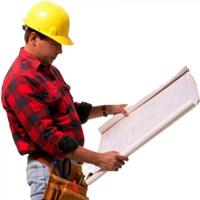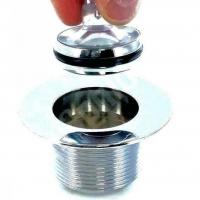No Need for a Plumber to Replace the Bathtub Drain
by Guest Post on Jan 19, 2010
If your bathtub drain needs to be replaced, either because it has become damaged or simply because it's not holding the water in the tub adequately anymore, there isn't a need to call a plumber. Replacing this drain is well within the reach for most do-it-yourself homeowners. Replacing this drain yourself will save you a significant amount of money, especially taking into consideration the prices that plumbers usually charge.
Preparations for Replacing the Drain
Before you start to replace a bathtub drain, you'll want to put down something to protect the bottom of your bathtub. This is not only to keep it clean but to prevent potential chips or scratches if you drop any tools into the bathtub while you are working. You'll also want to assemble some hand tools, such as screwdrivers and a pair of pliers, and any other tools you might need, depending on the style of bathtub drain you are dealing with. You'll also want to have some rags or towels handy.
Types of Bathroom Drains and How to Remove Them
First, you'll need to determine what type of bathtub drain you currently have. A common type of bathtub drain is the trip lever-style stopper. These come in two different varieties: a plunger style and a pop-up style. If you have a plunger style, you can’t see anything happening when you adjust the bathtub drain lever, because the plug itself resides down in the pipe. To deal with one of these, you will simply unscrew the face place, and pull the entire bathtub drain device out. If you find your tub is leaking because the stopper is bad, you can simply replace the stopper and reassemble.
If you have a pop-up style of a bathroom drain, first adjust the lever so that the stopper is at the highest level. Then, remove the stopper by either pulling it straight out or twisting and lifting.
There are also bathtub drains that don't include a lever. If you have a rollerball or foot lock style drain, turn it counterclockwise and pull it out. Some types of drains also require you to loosen a setscrew before you can remove them.
Pulling the Bathtub Strainer
Inside the drain itself, you will hopefully see crossbars. If your tub has crossbars in the flange, you can use a screwdriver and a pair of pliers to remove the drain by putting the pliers into the crossbar openings, and turning everything counterclockwise with the screwdriver to unscrew and remove it.
If your tub doesn't have crossbars, you are going to need a special tool that you can place into the flange. It can then be spread and tightened against the walls so that you can turn the flange and remove it.
Putting Everything Back Together
After acquiring any replacement parts that you find you need, you'll want to wash any fixtures that you are going to re-use with vinegar and baking soda. Then, put a line of plumbers putty around the underside of the strainer lip before screwing it back down into the tub drain, so that it is waterproof. Then, simply replace all the parts of the drain in the reverse order from how you removed them, and you're done.
Popular Articles
Three Places to Spend Money on the Exterior of Your Home
When you have the exterior of your home remodeled, you are investing, time, energy and convenience into the project and you want to make sure that...
95786 Views
Homemade Headboards-Make an Upholstered or Wooden Headboard
Homemade headboards can add a lot of personality to any bedroom. They can be coordinated with existing furniture and room decor or they can be the...
74454 Views
When to Use a Brush, Roller or Sponge Brush
Brushes are a good choice for painting trim and woodwork. They are also useful for cutting in the edges around the top and bottom edges and corners...
71821 Views
Creating a Cottage Kitchen with Bead Board
Kitchen decor can range from modern and bold to elegant and elaborate by using strategic kitchen pieces. One of the most popular decorating trends...
52898 Views
Gas Fireplace Diagnostics and Troubleshooting
Follow these steps for diagnosing and troubleshooting Gas Fireplaces repairs. For the average DIYer, this may seem intimidating, depending on the...
30639 Views
Latest Articles
How Much Does It Cost To Take A Bath?
Plumbers know that a bath may seem like a relaxing luxury, but the real cost extends far beyond your water bill. The average soak uses 35 to 50...
on Apr 8, 2025
10 Concrete Patio Ideas on a Budget
A concrete patio can be a game-changer for your outdoor space. It is durable, versatile, and can be customized to fit your style. But what if you...
on Mar 25, 2025
Tips for Creating a Stunning Personalized Photo on Canvas
Order the unique beauty of a personalized photo on canvas and bring your memories to life. With a customized photo on canvas, you can transform...
on Mar 7, 2025
Best Areas to Buy Property in Singapore for Long-Term Growth
Singapore's real estate market remains one of the most stable and lucrative in the world. With limited land supply, strong governmental...
on Feb 18, 2025
Troubleshooting Excess Water in Your HVAC Secondary Condensate Drain Pan
When maintaining your air conditioning system, it is easy to overlook the condensate drain pan - until excess water starts pooling in places where...
on Jan 12, 2025
Featured Articles
What Type of Licensed Contractor Should You Hire?
on Feb 28, 2017
Hire Contractors / Estimates

Looking for a specialty project? There are many types of contractors available for your home improvement needs. Finding the right type of...
Sponsored Articles
Best Areas to Buy Property in Singapore for Long-Term Growth
on Feb 18, 2025
Real Estate / Finance

Singapore's real estate market remains one of the most stable and lucrative in the world. With limited land supply, strong governmental...
Actions
Top Categories
- Garden / Landscaping / Patio — 264
- Kitchen / Bathrooms — 240
- Real Estate / Finance — 203
- Appliance / Repair — 186
- Interior Design / Decor — 184
- HVAC / Air Conditioning — 148
- Cleaning / Maintenance — 144
- Improvements / Remodeling — 131
- Plumbing / Basements — 118
- Floors / Tile / Hardwood — 116
- Doors / Garages — 113
- Safety / Security — 113
Articles Archive
More DIY Articles
Storm Protection Products and Installation
Window replacement is an expensive upgrade and many homeowners often do it in steps — first the street-side windows, next to the windows with the...
How to Lay a Concrete Floor
For many home renovation projects, you will need to lay a new concrete floor. It could be in a basement that you want to fix up, or perhaps for a...
Tips for Successfully Building a New Home
To successfully build a new home, first carefully examine any proposal given to you by a general contractor to ensure that everything is spelled...
Great Ways to Protect Floors from Furniture
Hardwood floors are beautiful and classic to have in your home, but an accidental scratch or dent can easily mar their appearance. Furniture...
Controlling Moisture in Your House
Dampness and moisture are notorious for damaging properties indiscriminately. In a recent estimate, 14,000 people experience water damage at home...

